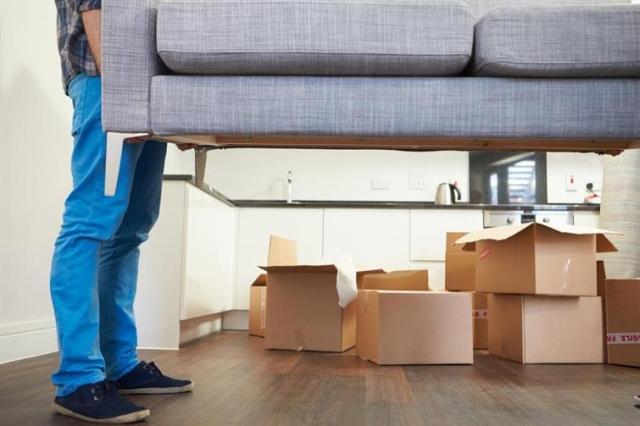Moving into your first apartment is great! It’s your own place to do what you want — no one will tell you to clean your dishes or pick up your socks (unless you’ll be living with a fussy roommate). But, first, you’ll need to move. Moving can be stressful for anyone, especially if you’ve never done it before and aren’t sure what to expect. Here are five tips to help you through the process.
1. Save the right amount for your apartment move
Here’s the golden rule when moving: it’s going to cost much more than you think. You might be aware that you’ll have to pay first and last month’s rent. But you will also pay a variety of move-in fees. These fees might include a security deposit, application fee, administration fee, and maybe even a pet deposit if you have a pet. Be sure to ask the apartment community or landlord if there are any additional costs, such as parking or storage fees.
Next, you’ll have to set up your utilities. You might have to pay a deposit on these to have them turned on before you move in. Find out which (if any) utilities are included in your apartment rent. Utilities you’ll need include water and sewer, electric, gas, trash collection, and internet. You’ll also want to get renter’s insurance.
If you are using a moving service, you’ll have to pay movers. You might need to buy specialty boxes, wrapping material, markers, and packing tape. If you are enlisting the help of friends and family, you might want to provide them with food. Those pizzas aren’t cheap, especially if you have a whole crew helping you on moving day. Speaking of pizza delivery and moving services, make sure you have some cash on hand for tipping.
You might want money available on moving day for stocking your fridge, buying necessary items that went missing during the move, and getting cleaning supplies.
2. Know how to pack a box
First, make lists. You need to write everything down and check items off as you complete them. There’s a lot to do when moving, including filling out a change of address card with the post office, informing friends and family of your new address, getting supplies, and so on. You might even want to make lists as you pack your boxes to keep track of what went where. Label every box. If you don’t, you will end up having to open and sort through every single box to find your coffee maker.
Don’t pack the towels in your linen closet. They will come in handy when packing. Use them to pad the bottom of boxes and to wrap delicate items. Tuck them into empty spaces in boxes to keep your breakables from shifting around in the box. And keep at least one out to clean your old apartment one last time after all the boxes are gone.
Don’t buy boxes if you don’t have to. Local grocery stores and other businesses will often have boxes you can take for free, so call around and ask when the best time to get boxes might be (some places have more boxes available on their delivery days).
Keep a few blankets handy to wrap large, breakable items like your television. Just wrap the blanket around it and secure it with packing tape.
Before taking anything apart or disconnecting wires from your television or computer, take pictures. When it comes time to reconnect and reassemble, you’ll be glad you did.
Use sandwich bags to keep small items contained. If you take furniture apart, you’ll likely have screws or nails you’ll want to find quickly when putting things together again. If the nails and screws are floating around in a box somewhere, they will get lost.
You can’t have too much wrapping paper or enough tape. You will likely need more of both.
3. Read your lease agreement and ask questions
While it is tempting to scroll (or flip) through to the last page and sign your name, you need to read your lease agreement. This document contains some very important information and if you don’t read it, you could inadvertently violate your lease or put your security deposit at risk. Your lease agreement lists everything you can and can’t do in your apartment. It provides information about rent and late fees, what you’ll need to know about having a roommate, guests, and pets, and it tells you what your rights and responsibilities are as a tenant. Make sure you know what you are agreeing to before signing and ask lots of questions.
Before you move in, schedule a walk-through with your landlord or property manager. During the walk-through, take a lot of pictures and videos of the empty apartment. You want pictures of every scratch, carpet stain, wobbly handle, dented cabinet, kitchen appliances — everything. Email the photos and videos as soon as you can (that day, if possible) to your landlord. This way, you’ll both have a time-stamped record of the walk-through results.
When you move out, you will need these photos to refer to if the landlord keeps your security deposit for damages. If the damages were there when you moved in, you aren’t liable for them.
Your landlord or property manager will likely have a checklist they’ll use during the walk-through. If there’s something you want fixed before you move in, ask the landlord for repairs. If the landlord agrees to make the repairs, get it in writing.
4. Have these necessities when moving into a new apartment
There are some things you’ll need on day one. Other items can be acquired later, such as decor and small appliances. Here are the essentials, room by room:
Bathroom essentials
- Toilet paper
- Towels and washcloths
- Shampoo
- Soap
- Toilet brush
- Toilet bowl cleaner
- Plunger
- Shower curtain (if there isn’t a shower door)
- Shower curtain rings (if you’re using a shower curtain)
- Bathmat
- Trash can
- Toothbrush holder
Bedroom essentials
- Bed frame and box springs (yes, technically, you could put the mattress on the floor, but we’re adulting here)
- Mattress and mattress pad
- Pillows
- Sheets, blankets, and pillowcases
- Hangers for the closet
- Curtains or blinds if there aren’t any installed
- A laundry basket
Kitchen essentials
- Plates and bowls
- Mugs and glasses
- Silverware
- Some pots and pans
- Knives (at least a chef’s knife)
- Scissors
- Cutting board
- Dish towels
- Paper towels
- Sponge
- Dishwashing liquid
- Toaster
- Coffee pot (if you consider coffee essential)
- Can opener
- Spatula
- Measuring cups and spoons
- Plastic storage containers
- Ice cube trays (if your refrigerator doesn’t have an ice maker)
- Kitchen trash bags
- Trash can
Household essentials
- All-purpose cleaner
- Glass cleaner
- Broom and dustpan
- Mop
- Bucket
- Lightbulbs
- Clips and rubber bands
- First-aid kit
- Laundry detergent
- Vacuum cleaner
Pantry essentials
- Vinegar
- Baking soda
- Flour
- Bread
- Coffee/tea
- Ketchup
- Mustard
- Rice
- Cereal
- Sugar
- Olive oil
- Salt
- Pepper
- Pasta
- Pasta sauce
- Canned vegetables and beans
5. Ask friends and family to help you move
If you need help moving, make sure you ask well in advance. If you ask the day before the move, it will be difficult to find anyone available. Remember that you are asking a huge favor so don’t be offended if they refuse. Be gracious when asking and let them know you would really appreciate the help.
Try to move on the weekend, if possible, when more people will be available to help. And as much as you want to control everything (it’s your move, after all), try to stand back and let your friends do what needs to be done. You’ll have plenty of time later to make sure the boxes are in the right room.
Provide food, snacks, and drinks. Your friends will get tired, so provide them with plenty of water and other drinks. Snacks will help keep energy levels and spirits up, so provide a few of your friends’ favorites. At the end of the day, reward all of them with pizza or dinner out. And, of course, offer to return the favor.
If you can’t find anyone to help or you will be moving out of state, you’ll want to hire movers. Do plenty of research and read reviews. Beware of moving companies that want cash up front or give you an estimate over the phone (they should want to see how much they will be moving before quoting you a price). Review moving company red flags to make sure the company you choose is reliable.
Moving into your first apartment is a big step. Hopefully, these tips will help you navigate the moving process with ease. Once the moving day dust settles, you can start decorating and making your apartment your own. But first, let the search for bubble wrap begin!






